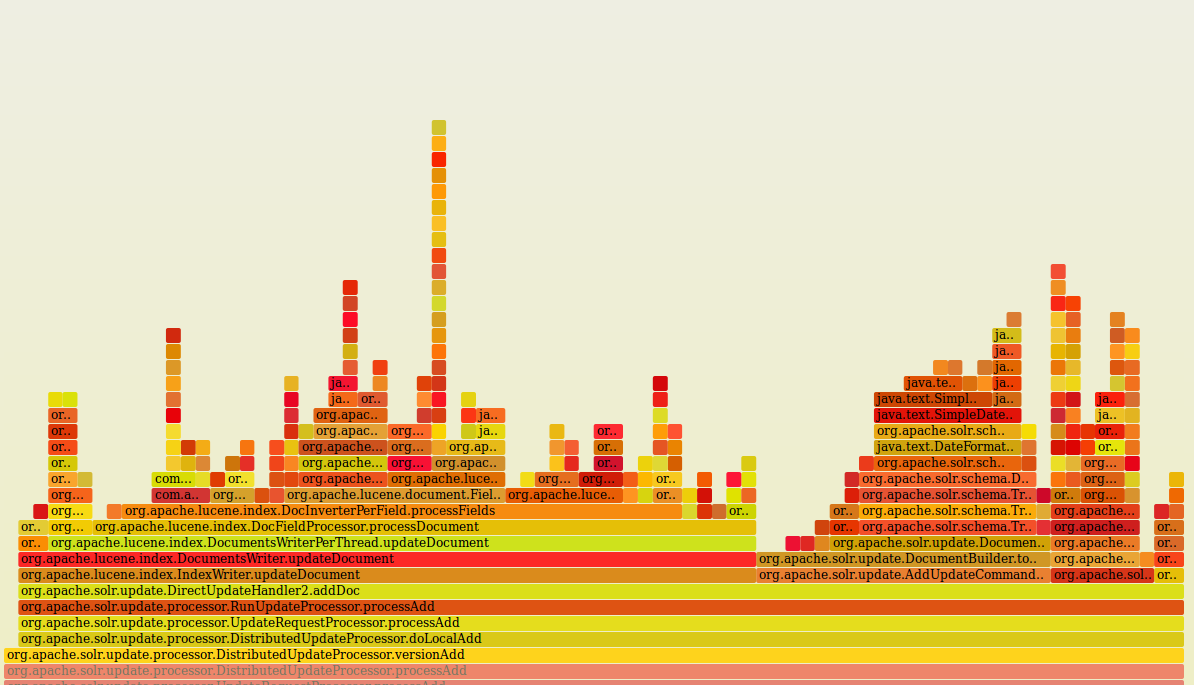Похожим образом, но с бо́льшим количеством выходных меток, создаётся классификатор на 5 классов:
public class FiveWayMNBTrainer {
private NaiveBayesMultinomialText classifier;
private String modelFile;
private Instances dataRaw;
public FiveWayMNBTrainer(String outputModel) {
classifier = new NaiveBayesMultinomialText();
classifier.setLowercaseTokens(true);
classifier.setUseWordFrequencies(true);
modelFile = outputModel;
ArrayList<Attribute> atts = new ArrayList<Attribute>(2);
ArrayList<String> classVal = new ArrayList<String>();
classVal.add(SentimentClass.FiveWayClazz.NEGATIVE.name());
classVal.add(SentimentClass.FiveWayClazz.SOMEWHAT_NEGATIVE.name());
classVal.add(SentimentClass.FiveWayClazz.NEUTRAL.name());
classVal.add(SentimentClass.FiveWayClazz.SOMEWHAT_POSITIVE.name());
classVal.add(SentimentClass.FiveWayClazz.POSITIVE.name());
atts.add(new Attribute("content",(ArrayList<String>)null));
atts.add(new Attribute("@@class@@",classVal));
dataRaw = new Instances("TrainingInstances",atts,10);
}
}
Тренировка классификатора
Тренировка алгоритма классификации или классификатора заключается в сообщению алгоритму примеров (объект, метка), помещённых в пару (x,y). Объект описывается некоторыми признаками, по набору (или вектору) которых можно качественно отличать объект одного класса от объекта другого класса. Скажем, в задаче классификации объектов-фруктов, к примеру на два класса: апельсины и яблоки, такими признаками могли бы быть: размер, цвет, наличие пупырышек, наличие хвостика. В контексте задачи распознавания тональности вектор признаков может состоять из слов (unigrams) либо пар слов (bigrams). А метками будут названия (либо порядковые номера) классов тональности: NEGATIVE, NEUTRAL или POSITIVE. На основе примеров мы ожидаем, что алгоритм сможет
обучиться и обобщиться до уровня предсказания неизвестной метки y' по вектору признаков x'.
Реализуем метод добавления пары (x,y) для классификации тональности на три класса. Будем полагать, что вектором признаков является список слов.
public void addTrainingInstance(SentimentClass.ThreeWayClazz threeWayClazz, String[] words) {
double[] instanceValue = new double[dataRaw.numAttributes()];
instanceValue[0] = dataRaw.attribute(0).addStringValue(Join.join(" ", words));
instanceValue[1] = threeWayClazz.ordinal();
dataRaw.add(new DenseInstance(1.0, instanceValue));
dataRaw.setClassIndex(1);
}
На самом деле в качестве второго параметра мы могли передать в метод и строку вместо массива строк. Но мы намеренно работаем с массивом элементов, чтобы выше в коде была возможность наложить те фильтры, которые мы хотим. Для анализа тональности (а быть может, и для других задач текстового машинного обучения) вполне релевантным фильтром является склеивание слов отрицаний (частиц и тд) с последующим словом: не нравится => не_нравится. Таким образом, признаки нравится и не_нравится образуют разнополярные сущности. Без склейки мы получили бы, что слово
нравится может встретиться как в позитивном, так и в негативном контекстах, а значит не несёт нужного сигнала (в отличие от реальности). На следующем шаге, при построении классификатора строка из элементов-строк будет токенизирована и превращена в вектор.
Собственно, тренировка классификатора реализуется в одну строку:
public void trainModel() throws Exception {
classifier.buildClassifier(dataRaw);
}
Просто!
I/O (сохранение и загрузка модели)
Вполне распространённым сценарием в области машинного обучения является тренировка модели классификатора в памяти и последующее распознавание / классификация новых объектов. Однако для работы в составе некоторого продукта модель должна поставляться на диске и загружаться в память. Сохранение на диск и загрузка с диска в память натренированной модели в Weka достигается очень просто благодаря тому, что классы алгоритмов классификации реализуют среди множества прочих интерфейс Serializable.
Сохранение натренированной модели:
public void saveModel() throws Exception {
weka.core.SerializationHelper.write(modelFile, classifier);
}
Загрузка натренированной модели:
public void loadModel(String _modelFile) throws Exception {
NaiveBayesMultinomialText classifier = (NaiveBayesMultinomialText) weka.core.SerializationHelper.read(_modelFile);
this.classifier = classifier;
}
После загрузки модели с диска займёмся классификацией текстов. Для трёх-классового предсказания реализуем такой метод:
public SentimentClass.ThreeWayClazz classify(String sentence) throws Exception {
double[] instanceValue = new double[dataRaw.numAttributes()];
instanceValue[0] = dataRaw.attribute(0).addStringValue(sentence);
Instance toClassify = new DenseInstance(1.0, instanceValue);
dataRaw.setClassIndex(1);
toClassify.setDataset(dataRaw);
double prediction = this.classifier.classifyInstance(toClassify);
double distribution[] = this.classifier.distributionForInstance(toClassify);
if (distribution[0] != distribution[1])
return SentimentClass.ThreeWayClazz.values()[(int)prediction];
else
return SentimentClass.ThreeWayClazz.NEUTRAL;
}
Обратите внимание на строку номер 12. Как вы помните, мы определили список меток классов для данного случая как: {NEGATIVE, POSITIVE}. Поэтому в принципе наш классификатор должен быть как минимум бинарным. Но! В случае если распределение вероятностей двух данных меток одинаково (по 50%), можно совершенно уверенно полагать, что мы имеем дело с нейтральным классом. Таким образом, мы получаем классификатор на три класса.
Если классификатор построен верно, то следующий юнит-тест должен отработать верно:
@org.junit.Test
public void testArbitraryTextPositive() throws Exception {
threeWayMnbTrainer.loadModel(modelFile);
Assert.assertEquals(SentimentClass.ThreeWayClazz.POSITIVE, threeWayMnbTrainer.classify("I like this weather"));
}
Для полноты реализуем класс-оболочку, который строит и тренирует классификатор, сохраняет модель на диск и тестирует модель на качество:
public class ThreeWayMNBTrainerRunner {
public static void main(String[] args) throws Exception {
KaggleCSVReader kaggleCSVReader = new KaggleCSVReader();
kaggleCSVReader.readKaggleCSV("kaggle/train.tsv");
KaggleCSVReader.CSVInstanceThreeWay csvInstanceThreeWay;
String outputModel = "models/three-way-sentiment-mnb.model";
ThreeWayMNBTrainer threeWayMNBTrainer = new ThreeWayMNBTrainer(outputModel);
System.out.println("Adding training instances");
int addedNum = 0;
while ((csvInstanceThreeWay = kaggleCSVReader.next()) != null) {
if (csvInstanceThreeWay.isValidInstance) {
threeWayMNBTrainer.addTrainingInstance(csvInstanceThreeWay.sentiment, csvInstanceThreeWay.phrase.split("\\s+"));
addedNum++;
}
}
kaggleCSVReader.close();
System.out.println("Added " + addedNum + " instances");
System.out.println("Training and saving Model");
threeWayMNBTrainer.trainModel();
threeWayMNBTrainer.saveModel();
System.out.println("Testing model");
threeWayMNBTrainer.testModel();
}
}
Качество модели
Как вы уже догадались, тестирование качества модели тоже довольно просто реализуется с Weka. Вычисление качественных характеристик модели необходимо, например, для того, чтобы проверить, переобучилась ли или недоучилась наша модель. С недоученностью модели интуитивно понятно: мы не нашли оптимального количества признаков классифицируемых объектов, и модель получилась слишком простой. Переобучение означает, что модель слишком подстроилась под примеры, т.е. она не обобщается на реальный мир, являясь излишне сложной.
Существуют разные способы тестирования модели. Один из таких способов заключается в выделении тестовой выборки из тренировочного набора (скажем, одну треть) и прогоне через кросс-валидацию. Т.е. на каждой новой итерации мы берём новую треть тренировочного набора в качестве тестовой выборки и вычисляем уместные для решаемой задачи параметры качества, например, точность / полноту / аккуратность и т.д. В конце такого прогона вычисляем среднее по всем итерациям. Это будет амортизированным качеством модели. Т.е., на практике оно может быть ниже, чем по полному тренировочному набору данных, но ближе к качеству в реальной жизни.
Однако для беглого взгляда на точность модели достаточно посчитать аккуратность, т.е. количество верных ответов к неверным:
public void testModel() throws Exception {
Evaluation eTest = new Evaluation(dataRaw);
eTest.evaluateModel(classifier, dataRaw);
String strSummary = eTest.toSummaryString();
System.out.println(strSummary);
}
Данный метод выводит следующие стастистики:
Correctly Classified Instances 28625 83.3455 %
Incorrectly Classified Instances 5720 16.6545 %
Kappa statistic 0.4643
Mean absolute error 0.2354
Root mean squared error 0.3555
Relative absolute error 71.991 %
Root relative squared error 87.9228 %
Coverage of cases (0.95 level) 97.7697 %
Mean rel. region size (0.95 level) 83.3426 %
Total Number of Instances 34345
Таким образом, аккуратность модели по всему тренировочному набору 83,35%. Полный проект с кодом можно найти на моём
github. Код использует данные с
kaggle. Поэтому если вы решите использовать код (либо даже посоревноваться на конкурсе) вам понадобится принять условия участия и скачать данные. Задача реализации полного кода для классификации тональности на 5 классов остаётся читателю. Успехов!











